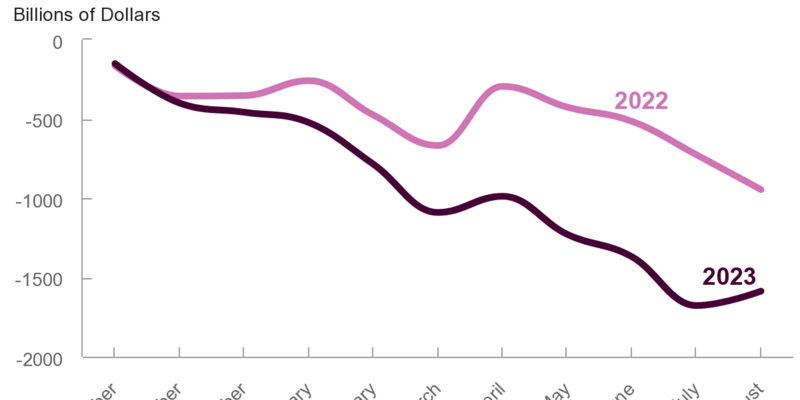
The federal budget deficit was $1.5 trillion in the first 11 months of fiscal year 2023, the Congressional Budget Office estimates—$0.6 trillion more than the shortfall recorded during the same period last year. Revenues were 10 percent lower and outlays were 3 percent higher from October through August than they were during the same period in fiscal year 2022.
Outlays in fiscal year 2023 were reduced by the shifting of certain payments—totaling $63 billion—from October 1, 2022 (the first day of fiscal year 2023), into fiscal year 2022 because October 1 fell on a weekend. If not for those shifts, the deficit through August would have been $1.6 trillion.
The deficit was larger in 2022 and is smaller in 2023 by amounts that are largely offsetting because of actions related to the Administration’s planned cancellation of outstanding student loans for many borrowers. The cancellation was never implemented because of the Supreme Court’s June 2023 decision prohibiting it. In September 2022, in accordance with the budgetary procedures used for federal credit programs, the Administration recorded outlays of $379 billion to reflect its estimate of the long-term costs of the debt cancellation, which increased the deficit in fiscal year 2022. In August 2023, the Administration recorded a roughly $330 billion reduction in outlays for the student loan program to reflect the Supreme Court’s decision. That action reduced the deficit for this fiscal year.
The outlay savings recorded by the Administration in August 2023 are less than the cost recorded in September 2022, primarily because a new income-driven repayment plan, which was finalized in June 2023, increases the cost of outstanding student loans. CBO provided an estimate of the cost of that plan in March 2023 and is preparing an update to account for additional rulemaking by the Department of Education and new projections included in CBO’s May 2023 baseline.
The recording of the reduction in outlays for the student loan program in August is the main reason for the upward bend in the 2023 line in Figure 1, which indicates a decline from July to August in the cumulative deficit for this fiscal year. That reduction also means that the difference between the cumulative 2022 and 2023 deficits for the first 11 months of the fiscal year is smaller than it would have been otherwise. Without it, the increase in the deficit for that period, adjusted for timing shifts, would have been larger—$1.0 trillion. The gap will narrow in September 2023 because of the large amount of outlays recorded in September 2022.
As reported in the Monthly Budget Review: July 2023, CBO updated its projection of the deficit for all of fiscal year 2023 to $1.7 trillion. Without the outlay savings recorded in August 2023 to reflect the Supreme Court’s ruling, that shortfall would be about $2.0 trillion. The deficit for fiscal year 2022 was $1.4 trillion. Removing the cost recorded in September 2022 for student loan debt cancellation, that amount would be $1.0 trillion. Excluding the effects of the changing plans for student loans, the deficit is on track to double from $1.0 trillion in 2022 to $2.0 trillion in 2023, CBO estimates.
Originally published at https://www.cbo.gov/publication/59474



